
ここからコンテンツです。

What's needed for educating students and young researchers
Kazuhiko Terashima

Education at national universities and graduate schools is currently at a turning point. Since the privatization of national universities in 2004, each university has had more autonomy and independence. At the same time, they have faced difficulties because of decreasing grant money for school management and serious competition in obtaining research funding. In this pressurized situation it is hard for universities to remain inventive, which in turn has made it difficult to maintain and keep improving the quality of research and education. Also, the type of person desired in the real world is changing as globalization keeps expanding, and universities and graduate schools are expected to produce graduates who are even more diverse and innovative.
In such a changing environment, what is Toyohashi University of Technology working on? We spoke with Dr. Kazuhiko Terashima, a researcher of robotics and system control and the executive trustee & vice president of the university, who has produced many graduates and instructors and has been actively involved in educational reform for a long time.
Interview and report by Madoka Tainaka
"The best feature of our institution is that we are truly a science and technology university. Eighty percent of our students transfer to our institution from Kosen (National Institute of Technology) for their junior (third) year. Many of our students are great at producing things, programming, and working with their hands.
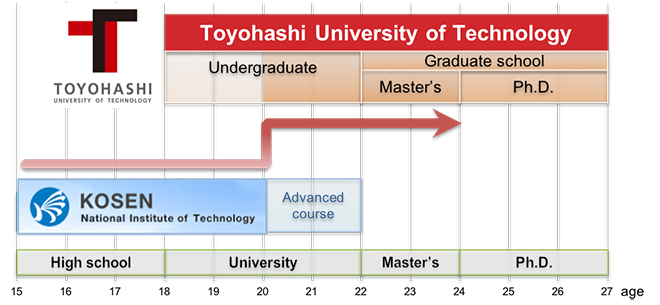
There are many foreign students and working adults attending our school, and in this diverse environment, we are trying to train our students to learn technologies properly, analyze them scientifically, and build theories that can be used universally. So, you can say that we are a university with a very unique character," says Dr. Terashima.
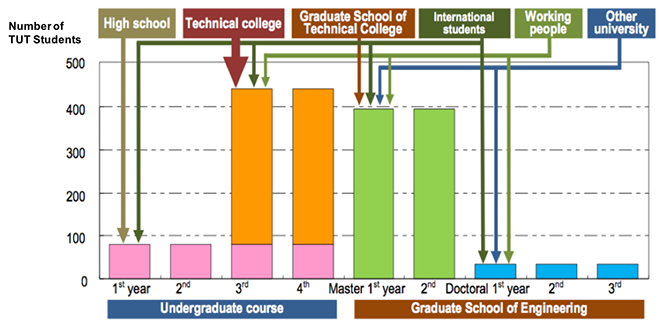
This unique character can be seen its university rankings.
- Out of 770 colleges and universities in Japan (according to Asahi Shimbun's 2019 university rankings), the university is ranked third in research grant money, KAKENHI (Grant-in-Aid for Scientific Research) per instructor (among universities established between 1966 to 1980)
- First in the total amount of collaborative research money shared with companies (for research projects under 300 researchers).
- In the passed years, our university has become champion 6 times in the NHK Student ROBOKON (NHK Student Robot Contest), and won second place in 2018.
We know that this university offers an environment in which students can really focus on their research.
A wide variety of support to cultivate young researchers
Dr. Terashima claims that the university's accomplishments, as seen in its rankings, are all the result of the steady and diverse efforts that are focused on global society and based on the university's strengths.
"We offer a six-week English training course at Queens College in the U.S. to faculty members and a study abroad program, of either one year or three months, to young researchers under the age of 50 in accordance with the 'The Top Global University Project' established by the Ministry of Education, Culture, Sports, Science and Technology."
"Also, we have many researchers who participate in and present at international conferences. On average, each researcher travels abroad once or twice a year. There are many collaborative research projects conducted with domestic and overseas companies and other institutions, and one of our advantages is that we receive a large amount of external funding for research."
Further, the university offers about one million yen in financial support to ten promising, young (up to 38 years old) faculty members for their research. The university has also implemented a "tenure-track system" to provide an environment in which younger researchers can be engaged with their research more independently. About 10 years ago, the university received funding from the Japan Science and Technology Agency (JST) and hired ten young researchers as tenure track faculty members of the university's Electronics-Inspired Interdisciplinary Research Institute. The university initially gave the tenure track faculty members 10 million yen, and later another six million yen for an additional five-year period. When the program funded by JST ended, another program was developed in which, every year, one assistant professor in order and per division was supported. They continued with this system for five years and it has just ended. Currently, a whole new program is being developed to hire associate professors on the tenure track.
"In addition to this sort of support, we receive research funding from outside the institution. So overall, the research environment we provide is one of the best in the country. For example, we have specialist university research administrators (URA) working at the Research Administration Center (RAC), with whom we are preparing a system to offer strong support for all research."
Enhanced support to develop global talent
Toyohashi University of Technology supports an environment for diverse learning for its students.
"We actively recruit students from overseas and prepare a good environment for them. Our current total student body numbers are around 2,000, and 269 of them, about 13%, are from overseas. These students come from 32 countries, many from Malaysia and other Asian countries, while others come from Germany and France for example. Many of them are pro-active about their experience with us, such as by starting their own venture companies by applying the knowledge they gained here. Naturally this provides a good stimulus to our Japanese students.
Our university provides bilingual Japanese and English education, partly due to our large foreign student body, and partly as one of our stated goals when we were chosen as one of the universities to carry out The Top Global University Project. So, for example, both textbooks and classroom instruction are provided in both languages for global courses. Also, there is a unique program involving about 180 students who are enrolled in our new Global Technology Architects Course (GAC). Under this program, almost all of them live in shared housing in groups of five which have a mix of Japanese and foreign students. It should also be noted that a six-week internship at a corporation is required in the student's senior (fourth) year.
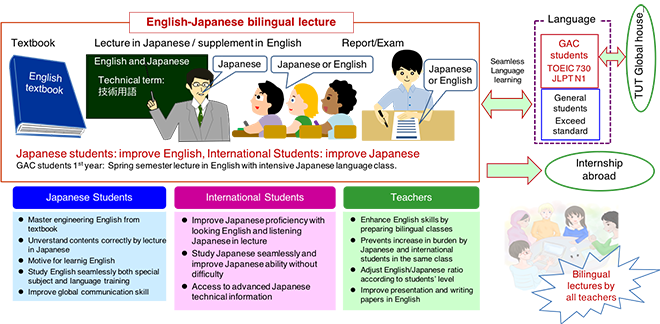
As a leading graduate school, Toyohashi University of Technology adopted the "Brain Information Architects" project for its doctoral students. In this program, a two-week trip to Malaysia and a six-month overseas internship are included. There are also double-degree programs available that produce elite education. These programs enable students to earn degrees at both Toyohashi University of Technology and at other institutions overseas, such as the University of Stuttgart in Germany and the University of Eastern Finland.
"These various efforts are resulting in an increased number of foreign students and Japanese students who can succeed globally. Many of our foreign graduates work at Japanese companies or assume the role of connecting Japan and their home countries."
Instructors' attitudes that are essential to education
Dr. Terashima mentions that, in addition to a wide variety of programs already being offered at the university, the the instructors’ attitudes to educate students is very important in order to produce promising talent.
"One unique characteristic of science universities in Japan is that a student joins a lab in his or her senior (fourth) year and is involved in research with instructors in a more hands-on environment (like a "temple school" in the Edo period). The concept of the Humboldt's educational model of 'teaching through research' is being truly carried out."
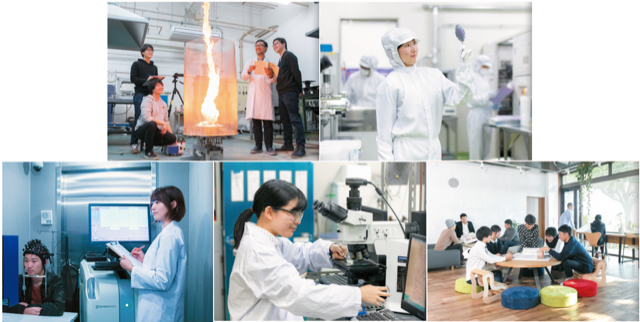
"What I think is essential here is the vision of the instructors. I myself have displayed to my students the roadmaps for five, ten, and twenty years from now for the research fields of robotics and system control. I have always been showing my students what kind of research we need to be involved in so that we can produce the best results in the world."
Another important point is making efforts to motivate the students. Experience in presenting at international conferences as well as domestic while in a master’s program not only helps bring students' motivation in research to a higher level, but it also trains them in their presentation skills and broadens their knowledge.
"It is also important to build a character with personality while engaging in self-study and self-learning in a free atmosphere. For this purpose, we need to have our students decide spontaneously their research subjects, research plans, and how to manage their labs on their own. Of course, during such processes, the instructors must provide full support while having constant communications with their students."
Thanks to these supportive education policies, Dr. Terashima's lab has already produced 341 graduates. Out of those graduates, about 30 of them have earned their doctorate degrees, and some have become instructors at universities and technical colleges.
"We are now in the so-called era of the 100-year-life and lifelong learning. Learning while you are young is particularly important. In my twenties, a research paper carrying my name as the first author was published in the world's leading journal. That experience made me want to become a researcher who can build theories of control that can be useful to people. I hope that the students and young researchers who learn at our university will be successful and help Japan and the rest of the world with the knowledge they gain here."
Reporter's Note
After the interview, Dr. Terashima showed me "Tera’s Sayings" (Teragoroku) titled "50 Tips for Adults." These are some of the tips he wrote while he was sick in bed at home for two days in his mid-forties, which he later posted on his blog. When I took a look at these tips, I read messages such as, "Have your own policies and philosophies about things. Don't be opportunistic," and "Have an area of specialty and deepen it. Nurture it with great care. 'Continuity leads to success.'" These messages were written for young people, but even at my age, I was deeply moved by many of these words. Dr. Terashima himself says with a smile, "I want young people to live freely without being too consumed by these guidelines. But, when they feel confused or stuck, I hope that they can draw some guidance or comfort from the blog." I do hope that many people have a chance to read it.
"Teragoroku"
http://www.syscon.me.tut.ac.jp/teragoroku_e/index.html
学生・若手研究者の教育に必要なこと
現在、国立大学・大学院教育は大きな変換点を迎えている。2004年の国立大学の法人化以降、それぞれの大学に自主性・独立性が求められると同時に、運営交付金の減少や競争的研究資金獲得の厳しさなどを背景に、各大学の創意工夫なくして、研究や教育の質を維持・向上させていくことが難しくなっているのだ。また、グローバル化に伴い社会で求められる人材も大きく変化し、大学や大学院に対して、より多様で、イノベーティブな人材の輩出が期待されている。
そうしたなか、豊橋技術科学大学はどのような取り組みをしているのか。ロボット・制御工学の研究者として、数多くの卒業生や教員を輩出するとともに、長年、大学の教育改革に取り組んできた寺嶋一彦理事・副学長に聞いた。
「本学の最大の特色は、まさに技術科学大学であることに尽きると思います。8割の学生が高等専門学校から3年次に合流する編入生で、ものづくりやプログラミングなど、手を動かすことに長けた学生が非常に多い。
留学生や社会人入学の学生などもいる多様な環境のなか、技術をしっかり身につけ、それらを科学的に解明し、普遍的に使える理論の構築をめざすという、じつに特色のある大学と言えます」と、寺嶋副学長は語る。
そうした特色は、大学ランキングにも垣間見ることができる。日本の全770大学のランキング(朝日新聞大学ランキング2019)で本学は、教員1人あたりの科研費配分額(大学設立年1966~1980年):第3位、企業との共同研究総額(研究者300人未満):第1位、またNHK学生ロボコンでは、過去6回優勝し、2018では準優勝するなど、研究に注力できる環境にあることがわかる。
若手研究者育成に向けた多様な支援
ランキングが示すような成果の背景には、本学の特色に根ざしつつ、グローバル社会を見据えた地道で多様な取り組みがあると寺嶋副学長は言う。
「文科省の『スーパーグローバル大学創生支援』事業のもと、教職員に対して、米国・クイーンズ大学にて6週間の英語教育を用意しているほか、50歳までの若手研究者を対象に、1年間もしくは3カ月間の海外留学制度を用意しています。また、本学では国際会議に参加、発表する研究者が多く、平均すると年に1~2回ほど渡航しています。国内外の企業や他機関との共同研究も多数あり、外部資金の獲得額が大きいことも特長でしょう」
さらに、優秀な38歳までの教員、十数名に対して100万円程度の研究費支援を実施しているほか、若手研究者が自立して研究が行える環境整備をめざす「テニュアトラック制」を導入している。10年ほど前に、科学技術振興機構(JST)の補助金を受けて、本学のエレクトロニクス先端融合研究所の若手研究者10名をテニュアトラック教員として採用。スタートアップに際して1,000万円、その後5年間の研究期間に対して600万円の研究費の支援を行ってきた。JSTの制度終了に伴い、毎年順番に、この制度を各系1名の助教に展開して5年が経過し、一応この制度を終了し、この取り組みの発展形として准教授採用へのテニュアトラック制の導入を始めたところだ。
「こうしたさまざまな支援に加え、科研費などの外部資金も併せることで、本学では日本の他大学に比べると恵まれた研究環境を実現しています。また、研究推進アドミニストレーションセンター(RAC)には、専門知識を備えたリサーチ・アドミニストレーター(URA)やコーディネーターがいて、研究を強力にバックアップする体制も整っています」
グローバル人材育成の支援も充実
一方、学生に対しても、多様な学びが得られる環境が用意されている。
「たとえば、留学生を積極的に受け入れ、そのための環境を整備しています。現在、学生約2,000人中269名と、約13%の学生が海外からの留学生です。出身国はマレーシアを筆頭に、アジア各国、さらにはドイツ、フランスなど32カ国にものぼります。留学生の中には、ここで学んだ成果を糧にベンチャー企業を立ち上げるアクティブな人も多く、日本人学生にとっても大きな刺激となっているのです」
留学生が多いこともあり、グローバルコースの授業については、スーパーグローバル事業の一環として英語と日本語の教科書を準備し、バイリンガルで実施している。また、グローバル科学技術アーキテクト養成コースの学生約180名は、原則として全員がシェアハウスに入居し、日本人と留学生が5人1部屋で生活をともにするというユニークな取り組みも行っている。4年次に、6週間もの企業実務訓練(インターンシップ)が必須単位となっていることも特筆すべきだろう。
博士人材に関しては、リーディング大学院として「ブレイン情報アーキテクト」プロジェクトが採択され、その中で2週間のマレーシア体験ができるほか、6カ月の海外インターンシップも用意されている。ドイツ・シュトゥットガルト大学や東フィンランド大学とのダブルディグリー・プログラム、すなわち本学と海外大学の両方で学位が取れるプログラムもあり、エリート教育も充実している。
「こうしたさまざまな取り組みが、留学生の増加につながり、グローバルに活躍できる日本人と、日本企業に就職、あるいは本国との架け橋となるような留学生を多数輩出することにつながっているのです」
教育のために不可欠な教員の心得
こうしたさまざまなプログラムが準備されていることに加え、有為な人材の輩出には、学生を育てる教育者側の心構えが大切だと寺嶋副学長は言う。
「日本の理系の大学で特徴的なのは、4年次から研究室に所属して、寺小屋的な環境のなかで教員とともに研究を行うことにあります。まさに、『研究を通じて教育する』というフンボルト理念が体現されていると言えます。
そこで不可欠だと思うのが教員のビジョンです。私自身、ロボット・制御工学の特定研究分野において、5年後、10年後、20年後のロードマップを提示して、世界一の研究成果を出すために、いまどんな研究をする必要があるかを学生たちに常に示してきました」
もう一つ重要なのが、学生のモチベーションを高めるための取り組みだと言う。国内学会はもとより、修士課程のうちから国際学会での発表を経験させることは、研究へのモチベーションを高めるだけでなく、プレゼンテーション能力を養ったり、見聞を広げたりすることにつながる。
「自学、自習を尊重し、自由な雰囲気のなか、個性ある人格を育てていくことも重要です。そのためには、研究テーマや研究計画、あるいは研究室運営などを学生自身にも自主的に決めさせ、実行させていくことが大切です。もっとも、その過程で教員は学生と対話しながら、最大限のサポートをしていかなければなりません」
こうした教育方針の結果、寺嶋副学長は研究室から341名の卒業生を送り出し、うち30名程度の博士を輩出、大学や高専の教員へと育て上げた。
「人生100年時代、生涯学習がうたわれる時代ですが、若いときの勉強はとくに重要です。私自身、20歳代で世界のトップジャーナルにファーストオーサーとして論文が掲載されたことを機に、人々に役立つ制御の理論を構築したいと、研究者の道を志しました。本学で学んだ学生、若手研究者が、ここで得たさまざまな経験を糧に、日本、世界のためにいっそう活躍してくれることを願っています」
(取材・文=田井中麻都佳)
取材後記
取材の後、「大人のための50箇条」と題した「テラゴロク」(寺嶋語録)なるものを見せてくださった。寺嶋副学長が40代半ばのあるとき、体調を崩して2日ほど自宅で寝ていたときに書き留め、後でブログにアップしたのだという。覗いてみると、「PolicyやPhilosophyを、いろいろなことに対して持て。日和見主義ではダメ」「専門をもち、それを磨け。大事に大事に育てよ。『継続は力なり』」といった言葉が続く。それらは若い人に向けたメッセージだが、この歳になったからこそ、しみじみと感じ入る言葉が多い。ご本人も、「若い人にはゴロクなんかに振り回されずに、伸び伸び生きてほしい。ただ、何か悩んだり立ち止まったりしたときに、ちょっと覗いて、指針にしてくれたら嬉しいですね」と笑う。ぜひ、多くの方に読んでいただきたいと思います。
Researcher Profile
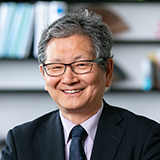
Dr. Kazuhiko Terashima
Dr. Kazuhiko Terashima received his PhD degree in engineering in 1981 from Kyoto University, Japan. Since 1982, he started his career at Toyohashi University of Technology and had been involved in the development of robotics and mechatronics. In this period, he was a visiting researcher at Technical University of Munich in German from 1990 to 1991. Currently Dr. Terashima is engaged in education and research as vice president at Toyohashi University of Technology.
Reporter Profile
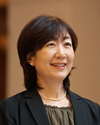
Madoka Tainaka is a freelance editor, writer and interpreter. She graduated in Law from Chuo University, Japan. She served as a chief editor of "Nature Interface" magazine, a committee for the promotion of Information and Science Technology at MEXT (Ministry of Education, Culture, Sports, Science and Technology).
ここでコンテンツ終わりです。
